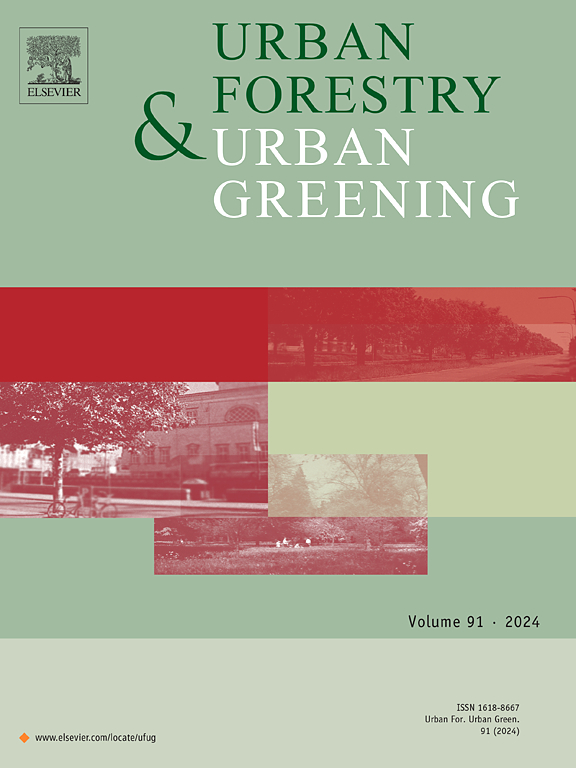Balancing cooling benefits and costs: Determining a moderate park scale in 24 Chinese cities
IF 6
2区 环境科学与生态学
Q1 ENVIRONMENTAL STUDIES
引用次数: 0
Abstract
Urban parks present an effective solution to mitigate urban heat, but their implementation can be costly. Thus, determining a moderate park scale is essential to balance cooling benefits and associated costs. However, the magnitude of park cooling benefits and their associated costs remain poorly understood. This study analyzed park cooling benefits and costs using high-resolution satellite data on land surface temperatures for 3258 urban parks in 24 Chinese cities. A novel method was developed to determine the moderate park scale for these cities. The study revealed that urban parks in 24 Chinese cities, on average, lower temperatures by 1.48 °C and extend this cooling effect over an average distance of 183 m. The cooled areas of urban parks account for 5.67 % of the total built-up area and benefit 18.13 % of urban residents. The total cooling benefit is estimated at 1.73 billion yuan, mainly due to the extended cooling effect. Park cooling costs are estimated at 0.83 billion yuan, resulting in net cooling benefits of 0.9 billion yuan across these cities. Beijing exhibited the highest park cooling benefits but also the highest cooling costs. The study identified a moderate scale range of 3.2–8.3 ha, which could enhance total and net cooling benefits by 25–50 % across these cities. Notably, in water scarce megacities like Beijing and Tianjin, smaller parks (3–4 ha) may yield the highest net cooling benefits.
平衡降温效益和成本:确定中国24个城市的适度公园规模
城市公园是缓解城市热量的有效解决方案,但其实施成本可能很高。因此,确定一个适度的公园规模对于平衡冷却效益和相关成本至关重要。然而,公园降温效益的大小及其相关成本仍然知之甚少。本研究利用中国24个城市3258个城市公园地表温度的高分辨率卫星数据,分析了公园降温的效益和成本。提出了一种确定城市公园适度规模的新方法。该研究显示,中国24个城市的城市公园平均降低了1.48°C的温度,并将这种降温效果平均延伸了183 米。城市公园降温面积占城市建成区总面积的5.67 %,惠及城市居民18.13 %。总体降温效益估计为17.3亿元,主要是由于延长了降温效果。园区降温成本估计为8.3亿元,这些城市的净降温效益为9亿元。北京的公园降温效益最高,但降温成本也最高。该研究确定了3.2-8.3 ha的中等规模范围,这可以使这些城市的总和净冷却效益提高25 - 50% %。值得注意的是,在像北京和天津这样缺水的特大城市,较小的公园(3-4 ha)可能会产生最高的净降温效益。
本文章由计算机程序翻译,如有差异,请以英文原文为准。
求助全文
约1分钟内获得全文
求助全文
来源期刊

Urban Forestry & Urban Greening
FORESTRY-
CiteScore
11.70
自引率
12.50%
发文量
289
审稿时长
70 days
期刊介绍:
Urban Forestry and Urban Greening is a refereed, international journal aimed at presenting high-quality research with urban and peri-urban woody and non-woody vegetation and its use, planning, design, establishment and management as its main topics. Urban Forestry and Urban Greening concentrates on all tree-dominated (as joint together in the urban forest) as well as other green resources in and around urban areas, such as woodlands, public and private urban parks and gardens, urban nature areas, street tree and square plantations, botanical gardens and cemeteries.
The journal welcomes basic and applied research papers, as well as review papers and short communications. Contributions should focus on one or more of the following aspects:
-Form and functions of urban forests and other vegetation, including aspects of urban ecology.
-Policy-making, planning and design related to urban forests and other vegetation.
-Selection and establishment of tree resources and other vegetation for urban environments.
-Management of urban forests and other vegetation.
Original contributions of a high academic standard are invited from a wide range of disciplines and fields, including forestry, biology, horticulture, arboriculture, landscape ecology, pathology, soil science, hydrology, landscape architecture, landscape planning, urban planning and design, economics, sociology, environmental psychology, public health, and education.
 求助内容:
求助内容: 应助结果提醒方式:
应助结果提醒方式:


